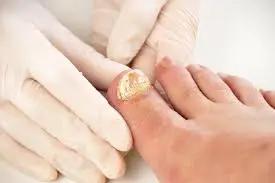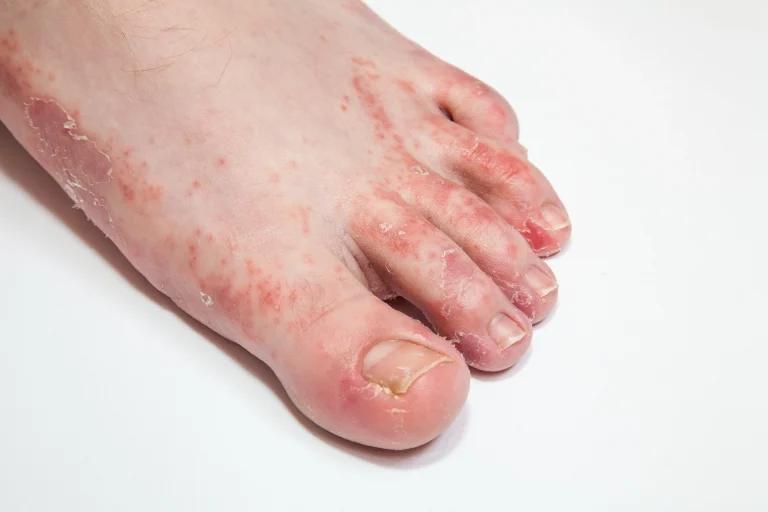Fungal nail infections, also known as onychomycosis or tinea unguium, are a persistent problem that can seriously impact the health of our nails, causing both cosmetic and medical complications. Understanding the underlying causes of these infections is the first step towards effectively preventing and treating them. Here, we will look more closely at the various factors that contribute to the development of fungal nail infections, giving you the knowledge to look after the health of your nails.
What is a fungal nail infection?
A fungal nail infection occurs when a dermatophyte, a type of fungus, infiltrates the nail bed and begins feeding on the keratin that makes up the nail. This can lead to a range of problematic changes in the appearance and structure of the affected nail. From discoloration and thickening to crumbling and separation of the nail from the nail bed. The symptoms of fungal nail infections can be both visually unappealing and painful.
Common causes of fungal nail infections
Fungal nail infections can be caused by a variety of sources. By understanding these causes, individuals can take the necessary steps to minimize their risk and maintain the health of their nails.
Exposure to fungal environments
One of the main ways individuals contract a fungal nail infection is through exposure to these opportunistic microorganisms. Public areas such as swimming pools, locker rooms, and showers are breeding grounds for fungal growth, as the moist, warm conditions create an ideal enviroment for these microbes to live and grow. Walking barefooted in these places increases the chance of picking up the fungus and transferring them to the nails.
Weakened immune system
Individuals with weak immune systems, due to underlying medical conditions or certain medications, are at a higher risk of developing fungal nail infections. Conditions such as diabetes and HIV/AIDS can weaken the body’s ability to fight off fungal infections, making the nails more vulnerable.
Nail trauma and injuries
Damage to the nails, such as cuts, cracks, or ingrown nails, can provide a point of entry for fungal spores into the nail bed. Nail trauma can occur from incorrect nail trimming, wearing ill-fitting shoes, or even from minor accidents.
Genetic predisposition
Some individuals may be genetically more likely to develop fungal nail infections. This may be linked to factors such as nail composition, pH balance of the skin, or the body’s immune response to fungal microorganisms.
Poor circulation and diabetes
People with poor blood circulation are often associated with conditions like peripheral vascular disease, and are more prone to fungal nail infections. Reduced blood flow can impair the body’s ability to fight off fungi. Also, people with diabetes, a condition that can compromise immune function, are at an increased risk of developing fungal nail infections.
Excessive sweating
Excessive sweating can create an environment conducive to fungal growth. Warm, moist conditions generated by excessive perspiration can increase the growth of fungal organisms, increasing the chance of nail infections.
Advancing age
Nails undergo changes as we get older, including a thickening of the nail plate and a reduction in blood flow to the nail bed. Age-related alterations can make nails more vulnerable to fungal infections, with its prevalence rising significantly in those over the age of 60.
Signs and symptoms of fungal nail infections
Recognizing the signs of a fungal nail infection is vital for seeking appropriate treatment. Common symptoms include:
- Discoloration of the nail, to white, yellow, or brown
- White or yellow streaks or spots on the surface of the nail
- Thickening and distortion of the nail shape
- Crumbling of the nail
- Separation of the nail from the nail bed
- Foul nail odor
The severity of symptoms can vary, in some cases, the infection may be asymptomatic, making regular nail inspections essential for early detection.
Diagnosing fungal infections of the nail
Healthcare professionals, such as dermatologists or podiatrists use visual examination and laboratory testing to confirm fungal infections.
Visual examination
A healthcare provider will inspect the affected nail. Visual examination can provide valuable insights, but it may not always be sufficient to identify the underlying fungus.
Laboratory testing
Healthcare providers may collect a sample of the affected nail for further analysis. This may include microscopic examination and fungal culture testing. These tests can confirm the presence of a fungal infection and also help identify the specific type of fungus responsible, guiding selection of the most effective treatment.
Preventing fungal nail infections
Prevention of the development of fungal nail infections can be highly effective in maintaining the health and appearance of nails. Key strategies include:
Foot hygiene
Washing and drying feet regularly, especially between the toes, can help create an environment less conducive to fungal growth. Wearing clean socks and not sharing personal items, such as towels or nail clippers, can help reduce the risk of contamination.
Public areas
When visiting swimming pools, public showers, gyms or locker rooms, wear protective footwear, such as flip-flops or shower shoes, to reduce contact with contaminated surfaces.
Treating underlying conditions
Those with other medical conditions that increase the risk of fungal nail infections, should work closely with healthcare providers to manage these conditions effectively and reduce the risk of complications.
Maintaining proper nail care
Proper nail trimming and filing techniques, as well using clean, disinfected nail tools, can help prevent nail injuries and create an environment that is less favorable for fungal growth.
Addressing Athlete’s Foot promptly
Recognizing and treating athlete’s foot (tinea pedis) quickly is vital, as this fungal skin infection can spread to the nails.
Individuals can significantly reduce their risk of developing fungal nail infections and maintain the health and appearance of their nails, by implementing these preventive measures
Treating fungal nail infections
Treating fungal nail infections can be a complex and challenging process, as these fungi can be difficult to eradicate. With the guidance of healthcare professionals and the availability of various treatment options, it is possible to manage and even resolve these infections.
Oral antifungal medications
Oral antifungal medications such as terbinafine (Lamisil), itraconazole (Sporanox), and fluconazole (Diflucan) are prescribed for several months to achieve the desired results. These target the fungus, inhibiting its growth, allowing the nail to grow, healthy and clear of the infection.
Topical antifungal treatments
Topical antifungal solutions and lacquers can be applied directly to the affected nail. These treatments are designed to penetrate the nail and the surrounding tissue to eliminate the fungal infection. These are often used in combination with oral medications for more severe or resistant cases.
Laser treatment
Laser and light-based therapies are alternative treatment options for fungal nail infections. These procedures use focused energy to disrupt the fungal organisms, leading to the temporary improvement of clear nail growth. These treatments generally have lower cure rates compared to oral and topical antifungal medications.
Nail removal
When the infection is severe or has not responded to treatments, a healthcare provider may recommend the partial or complete removal of the infected nail. Nail avulsion, is typically performed under local anesthesia and can create an environment less favorable for the fungus to live, allowing for the regrowth of a healthy nail.
Combination therapies
For stubborn fungal nail infections, healthcare providers may recommend a combination of oral antifungals, topical therapies, and laser or light-based interventions. This can increase the likelihood of eradicating the fungal infection successfully and prevent its recurrence.
Living with fungal nail infections
You can employ strategies to manage and maintain your quality of life when you have a fungal nail infection.
Cosmetic considerations
It’s generally not recommended to cover up a fungal nail infection with nail polish, but there are cosmetic options, such as nail polish designed for use on fungal nails, that can help improve the appearance of the nail, without making the condition worse.
Discomfort and pain
Over-the-counter pain killers and properly fitted footwear can help alleviate discomfort and pain and improve the overall quality of life.
Emotional support
Feelings of embarrassment or even social withdrawal can arise when suffering with fungal nail infections. Support from healthcare providers, friends, and family, or even joining online communities, can help you cope with the emotional aspects of this condition and maintain a positive outlook.
Conclusion
Fungal nail infections are a common condition that can affect the appearance and health of nails. By understanding the various causes of these infections, individuals can take the necessary steps to prevent their occurrence and seek timely treatment.
Sources
Medical Disclaimer
NowPatient has taken all reasonable steps to ensure that all material is factually accurate, complete, and current. However, the knowledge and experience of a qualified healthcare professional should always be sought after instead of using the information on this page. Before taking any drug, you should always speak to your doctor or another qualified healthcare provider.
The information provided here about medications is subject to change and is not meant to include all uses, precautions, warnings, directions, drug interactions, allergic reactions, or negative effects. The absence of warnings or other information for a particular medication does not imply that the medication or medication combination is appropriate for all patients or for all possible purposes.






